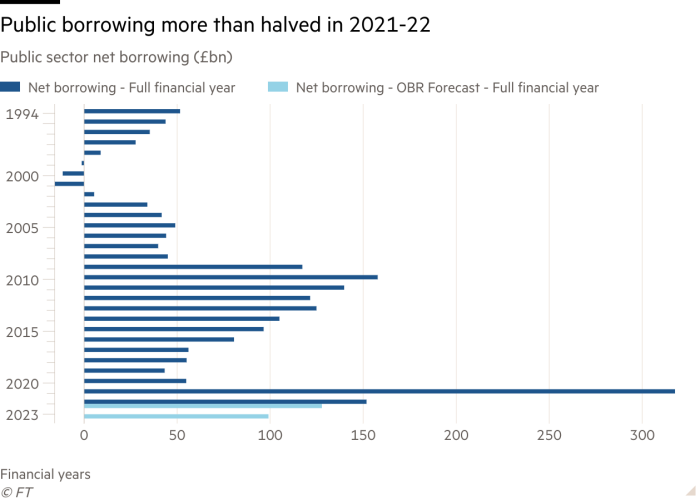UK government borrowing more than halved in the 2021-22 financial year ending in March as the economy bounced back from the pandemic, giving the chancellor more scope to address the cost of living crisis.
The Office for National Statistics’ initial estimate of public sector net borrowing for 2021-22 was £151.8bn, down more than 50 per cent from the £317.6bn in 2020-21 when the coronavirus crisis was at its worst.
This provisional data was worse than the £127.8bn that the government’s fiscal watchdog, the Office for Budget Responsibility, predicted in its March forecast for the financial year. But with tax receipts strong, economists said the final official figure was likely to improve significantly as further spending data came in from government departments.
Representing approximately 6.4 per cent of national income, the level of government borrowing was lower than the total of the five years following the 2007-08 global financial crisis, indicating a much more rapid economic recovery from the virus.
Economists said the figures were better than expected and that the ONS would soon revise down the estimates for borrowing in 2021-22.
Michal Stelmach, senior economist at KPMG UK, said the £24bn difference between the OBR’s forecast and the ONS figures stemmed from an assumption made by the fiscal watchdog that many government departments would not have spent their full budgets in 2021-22.

“The key difference stems from [the OBR’s] judgments, which are yet to appear in the published data, in particular in relation to greater departmental underspends, lower investment by local authorities, and an expected downward revision to the cost of the Covid-19 loan guarantee schemes,” Stelmach said.
Samuel Tombs, UK economist at Pantheon Macroeconomics, noted that “early estimates of borrowing recently have been revised down significantly, as more data have been collated”. He said that tax revenues were higher than the OBR had predicted for the full financial year and government spending numbers were often revised down significantly.
The healthy situation for the public finances gave Rishi Sunak, the chancellor, scope to alleviate the pain from the cost of living crisis, according to James Smith, research director of the Resolution Foundation think-tank.
A “revenue rich” recovery, Smith said, implied that “the chancellor can have little reason not to provide much-needed policy support to families as they deal with the higher inflation and energy bills that are now hitting their finances”.
Sunak, however, gave no hint that he was considering any imminent further action to help households. In a statement after the figures were published, the chancellor highlighted the support he said he had already offered.
“We must manage public finances sustainably to avoid saddling future generations with further debt,” he added.
Tax revenues were strong in March and across the whole of 2021-22. Central government revenues totalled £830bn in the financial year, some £6.5bn more than the OBR forecast at the time of the Spring Statement.
In response to the data, the OBR said the strength in revenues was “broad based with all the major taxes recovering strongly” and the improvement had continued even as the wider economic recovery took a hit from higher energy prices.
High inflation tends to raise government revenues both because spending is higher in the short term as prices rise and many thresholds in the tax system are fixed in cash terms.
The fiscal watchdog said strong revenues was “thanks to strong growth in the cash size of the economy”.
But it did sound a note of caution on the public spending side of the government budget. The initial figures showed central government spending was £33.8bn higher than it had expected, reflecting big overshoots in purchases in goods and services as well as net investment.
Some of that was likely to be revised down, the OBR said, but it noted that the forecast miss was large enough for it to wonder whether there had indeed been a surge of government spending at the end of the financial year.
Net public investment was also £18.5bn higher than the OBR expected with £7bn likely to be automatically revised away once the ONS takes account of government policy changes on student loans and lower estimates of likely losses on Covid loan guarantees.
But, the watchdog indicated that some of the additional spending was likely to be real and this suggested, “supply bottlenecks may not have impinged on capital outlays at the end of the year by as much as [we] expected”.
https://news.google.com/__i/rss/rd/articles/CBMiP2h0dHBzOi8vd3d3LmZ0LmNvbS9jb250ZW50LzM4ZWFmZTNjLTBhOWMtNGJlMS1iZGYwLWFhMWU2NjMwN2Q4MNIBAA?oc=5
2022-04-26 13:24:11Z
1399771561
Tidak ada komentar:
Posting Komentar